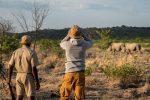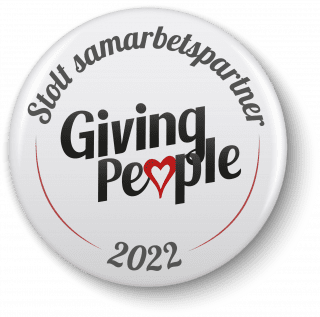The word Namibia means in local language “a big place” and it makes good sense, as the country is both enormously large (roughly 20 times as big as Denmark) and since only 2.5 million people live here. Here you can climb the highest sand dune on the planet, look down into Africa’s deepest valley and experience the wildest nature. Look back in history and into yourself, experience how mountains and plains form a fascinating mosaic. Welcome to one of the oldest and driest desert areas on the planet.
Contact form

Ecorating: 3.5
This product meets our requirements for Ecorating, a product that is good for humans and the environment.
Does my trip make a difference?
Read more
This product meets our requirements for Ecorating, a product that is good for humans and the environment.
Sample Itinerary
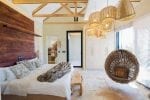
Welcome to Namibia!
You land in Windhoek, the capital of Namibia. Your driver is waiting for you and will take you to your hotel. Relax and recharge your batteries.

Have a good breakfast on the terrace before heading out to the airport and the journey to Kuala Desert Lodge. Tucked away at the foot of the impressive Sossusvlei sand dunes, this adventurous lodge offers a kind of private access to the Namib Naukluft Park. From the lodge you have a beautiful view of the famous red sand dunes, the mountains and the great plains. This is the only lodge with direct access to Sossusvlei.

Activities you can take part in include private trips to Sossusvlei, nature walks and safaris to experience the desert’s diversity of flora and fauna. If you want to spend a little more money, you can also ride a horse, fly a balloon or go for a ride in a four-wheel drive.
You will almost certainly see springbok, chamois, ostrich, ear fox and perhaps earth wolves, an animal in the hyena family. Animals that cope in these harsh and extraordinary conditions, the experience is great. All activities are permeated by the special peace and quiet that reigns here.I
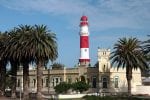
Today we are going on to Swakopmund. The city is located between the Atlantic Ocean and the Namib Desert, and here you will meet the very special German-African culture with whimsical architectural elements. The city offers lots of atmosphere and some German “gemütlichkeit”. Go down to the beach, eat fresh oysters or try how “sand boarding” works.

After breakfast we say goodbye to Swakopmund to take the plane to Damaraland Camp. You land in the heat and dust of the stunning landscape which is Damaraland.c The camp is located in one of the wildest natural areas in Namibia, on the north side of the Huab River Valley. Here you can enjoy a fantastic view of the desert, the plains and the Brandberg mountains.

It is the rain that dictates the conditions here. When the rain falls and the river gets filled with water again, animals come to drink and live along the river. It is an intensive spectacle that only happens once or twice a year. However, you can always and all year round still go on safari to find, for example, the desert-living elephant, chamois, springbuck, from time to time lions and black rhinos. Here are also exciting plants and trees like Euphorbia and Shepherd’s Trees. During the trip we also pass Twyfelfontein, where you can see rock engravings over 2,500 years old.
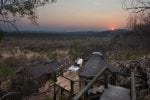
We travel on to Ongava Lodge. The lodge is located in the privately owned Ongava Game Reserve up against the southern border of Etosha National Park, and the location is close to the top of a hill at the foot of the Ondundozonanandana ridge. Nice view and close by is also a water hole where animals come to drink.
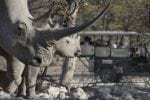
The clear morning air is often filled with the sound of birds and the roar of lions – a good start to the day. Today we might be looking for rhinos, which is also planned safari in Etosha National Park ,. Tonight you sit by the campfire and watch the animals by the waterhole, enjoy the silence and feel how Africa is getting close.

Thanks and goodbye Namibia for this time!
Trip details
When can you travel?All year round but it can be very hot in December and January. The coldest are in June and July.
Airport: Windhoek (WDH)
Duration: 7 nights
The price includes: International round trip flight, full board at the safari lodges and breakfast at the hotels in Windhoek and Swakopmund, all activities in the program, transfer to and from the airport.
Price does not include: Travel insurance, tips, extra activities and meals outside the planned program.
Good to know about Namibia:
Mobile coverage and internet: Coverage in the larger hotels but not during your stay in the desert
Visas: Danish citizens do not need visa but your passport must be valid for a minimum of 6 months from entry. There must be at least two blank pages in the passport passport.
Time zone: GMT + 1
Vaccinations: Read more at Statens Serum Institut
Local currency: Namibian dollar
Weather: Windhoek, Namibia
Water: Clean water in the camp and in the hotels
Safety: Good

Ecorating: 3.5
This product meets our requirements for Ecorating, a product that is good for humans and the environment.
Does my trip make a difference?
Read more
This product meets our requirements for Ecorating, a product that is good for humans and the environment.
Damaraland Camp: Damaraland Camp is the successful result of a partnership between Wilderness Safaris and Torra Conservancy, and has become an inspiration for communities and conservationists throughout Africa. In addition, the camp has been built to be as environmentally friendly as possible, which minimizes its environmental impact and continues to express its 4Cs vision. The core considerations in sustainable planning are conservation, community, culture and commerce.
Community Partnership: Collaborative Partnership – Torra Conservancy
Wilderness Safaris and the Torra community in Damaraland have formed a solid and successful partnership where one can say that the local community functions as worthwhile for the safari activities. The result is that 352,000 hectares of nature are under protection, desert flowers and sniper activities have been severely restricted.
Eco camp: In Damaraland Camp, the traditional local culture and ways of acting are combined with new technology – an example is the sandbags used to build the camp’s road system. Other durable ways to use environmentally friendly technology are the building materials used, such as canvas, reed mats, rubber and grass roofs. Natural light and convection are allowed to work together to minimize the need for electric light and air conditioning.
Green operating systems: The camp is supplied with electricity from a hybrid system. The system consists of a diesel-powered generator which charges a battery pack, which in turn supplies electricity for the periods when you need it. In this way, the use of the generator is minimized to the highest necessary. All tents have their own photovoltaic system, which supplies electricity to LED lamps and other things, and the hot water comes from another photovoltaic system.
Wastewater is treated in the camp’s own facility, which means that the water you discharge into nature is again treated.
Pack for a Purpose: Wilderness Safaris has partnered with Pack for a Purpose, an NGO aimed at giving camp guests up-to-date information on the things you as a guest can bring to the local community. If you want to know more, feel free to drop by the projects you can support through thePack for a Purpose
Kuala Desert Lodge: In 1996, Wilderness Safaris founded this camp near Sossusvlei. On the spot, they had previously had goats walking, which had lived in relatively good harmony with the original animals in the area. Today the goats are gone, but more wild animals live here.
Kulala Wilderness Reserve: With the return of the original wildlife, a major project was carried out with the aim of removing fences and fences throughout the area. This is to make it easier for the animals to move freely without obstacles. When the animals were able to move freely again, it gave new energy to the whole ecosystem, and nature flourished in that the original circuits could function again. Eventually, the fence that had separated the Kulala Wilderness Reserve (KWR) and the Namib Rand Nature Reserve was removed. There is still separation between KWR and the nearby Namib-Naukluft National Park.
Energy-saving initiatives: Kulala Desert Lodge covers its energy needs using a hybrid system that combines solar energy and a diesel-powered generator. The sun’s energy provides 66% of the electricity used. All tents have their own photovoltaic system, which is primarily used to get hot water.
Ongava Lodge: Here you are deeply committed to protecting and respecting nature and wildlife. One has the basic attitude that man is a part of but also a guest in nature, and that man is part of a larger ecosystem which must be treated with care.
